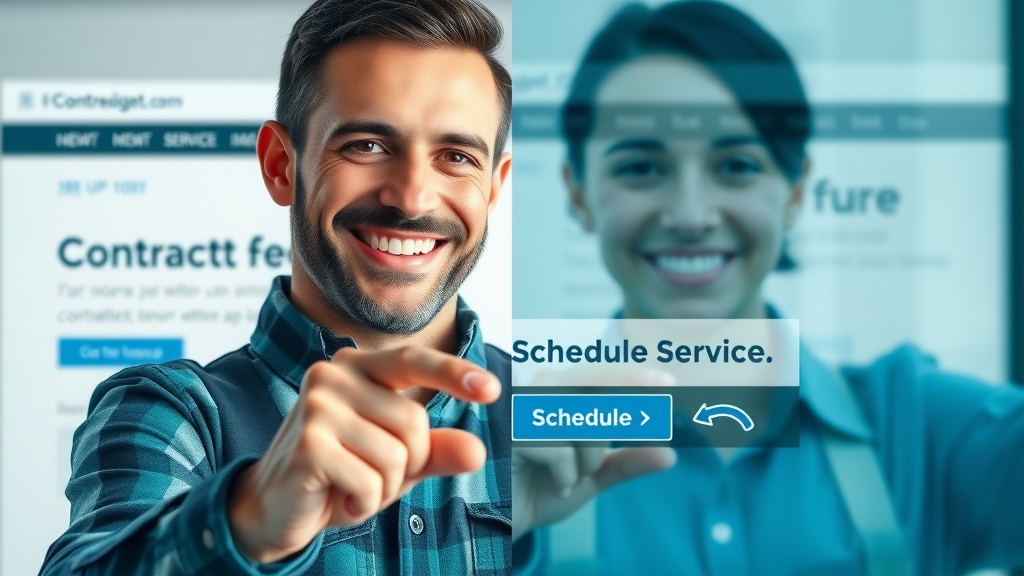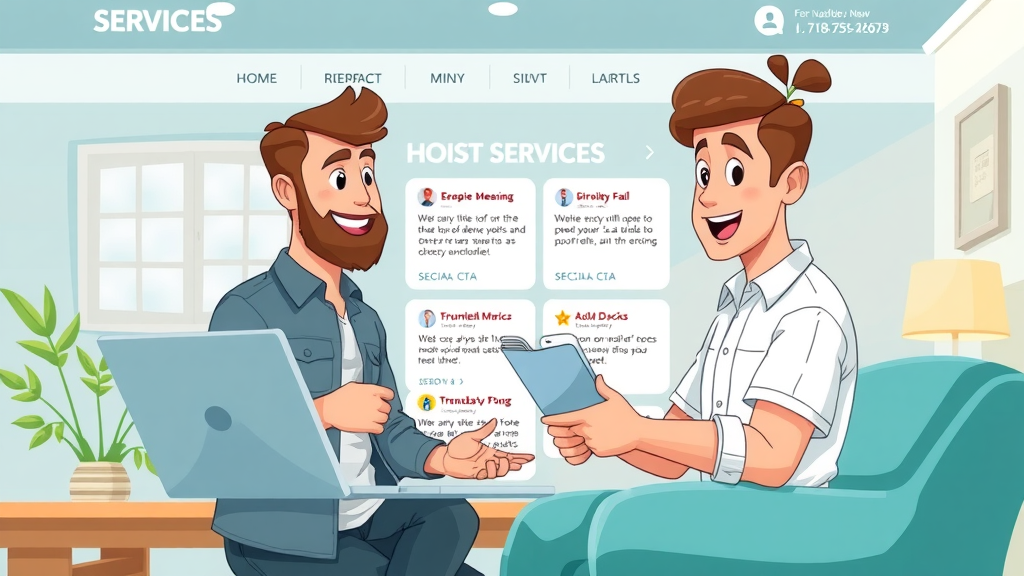Did you know? Most home service contractor websites convert less than 3% of their visitors into paying customers. That means over 97 out of every 100 potential customers leave your site empty-handed! But it doesn’t have to be this way. With simple, actionable changes and a smart understanding of website conversion, you can shatter those averages, grow your business, and make your website your most powerful sales tool.
In this guide, you’ll discover surprising industry facts, proven techniques, and simple strategies to boost your website conversion rate. Whether you’re a plumber, HVAC specialist, electrician, or cleaning service owner, every tip you’ll find here is designed to turn curious visitors into loyal clients—fast and efficiently.

Unlocking the Power of Website Conversion: Surprising Statistics Every Home Services Contractor Should Know
- Startling statistic: The average conversion rate in the home services industry often lingers below 3%. Learn why most websites fail to convert visitors, and how your business can break the mold.
Many home services businesses invest heavily in ads and search rankings, only to see website visitors vanish without a trace. Why? Because most contractor sites aren't built with conversion in mind. Understanding what drives a website conversion is the first step to outperforming your competition. Imagine if you could raise that conversion rate from 3% to just 5%—that’s nearly doubling your incoming leads and jobs. Each percentage point you gain means more service calls, more bookings, and a busier business.
Breaking free from industry averages begins with recognizing key website conversion barriers and implementing small but powerful changes. This article will reveal how home services contractors are successfully using conversion rate optimization to turn visitors into paying customers and how you can too. With just a few tweaks, you can connect with more potential customers, boost your conversion goal results, and grow your business’ revenue month after month.
Understanding Website Conversion and Types of Website Conversions
What is Website Conversion and Why Does it Matter for Contractors?
A website conversion happens when a website visitor takes action you want, like making a booking, filling out a contact form, or calling your business. For home services contractors, this might mean a customer requests a quote for plumbing repair, schedules an HVAC service visit, or signs up for a maintenance plan. Every conversion moves a potential customer closer to becoming a paying client.
Focusing on website conversion turns your site from an online brochure into a lead-generating machine. Higher conversion rates mean more of your site visitors are turning into potential customers —not just browsing, but taking steps to use your services. And with digital competition fierce, this is more important than ever. Even with a steady flow of web traffic, if nobody acts, you’re missing vital business opportunities.
Measuring your conversion rate (the number of conversions divided by the number of visitors) lets you see how effectively your site turns interest into action. This is the heart of rate optimization —knowing how many people reach your site and how many do what you want them to do (such as booking, calling, or making a purchase).
Types of Website Conversions That Matter for Home Services Businesses
Different types of website conversions play a big role for home services companies. Conversions aren’t just about sales—they include any action that moves website visitors closer to hiring you. High-impact conversions for contractors include:
- Form Submissions: A visitor fills out a contact form or requests a quote.
- Phone Calls: Clicking a phone number to call your business directly from the website.
- Online Bookings: Scheduling a service appointment through your booking system or landing page.
- Email Signups: Visitors subscribing to your offers or updates using their email address.
- Live Chat Messages: Initiating a conversation with your sales or support team online.
Some websites may also track downloads (like brochures or service guides), requests for callback, or even social media follows as conversions. Each of these conversion goals helps you move a visitor along the customer journey—whether that’s immediate service, becoming a lead, or nurturing them for future business. Optimizing each type will help you connect with more potential customers and ultimately drive better conversion rates.

Conversion Goals: Moving Website Visitors Along the Customer Journey
A well-defined conversion goal keeps your whole web design and marketing strategy on track. For home services contractors, the primary goal is usually to turn site visitors into booked service appointments or qualified leads. But, there’s a journey involved—most people don’t convert on their first visit.
Guide visitors to take small, measurable steps: viewing your services page, reading testimonials, signing up for a newsletter, or requesting a callback. Each step is a micro-conversion that brings someone closer to the main conversion goal: a new job or client. When you map out the customer’s journey and set goals for each stage, you make it easy for website visitors to find what they need and act quickly.
Monitoring how visitors travel through your site lets you spot points of friction. Are people dropping off at the quote request form? Not clicking your main “Book Now” button? By understanding these journey points, you can fine-tune every web page for higher conversion.
The Anatomy of a High-Performing Website Conversion Funnel
Important Stages of the Conversion Funnel for Website Visitors
Think of your website conversion funnel as a path potential customers take—from landing on your home page to finally booking a service. There are three main funnel stages:
- Top of Funnel: Visitors become aware of your business, often landing on your website from search engines or digital ads.
- Middle of Funnel: They learn more, browse your service and product pages, and consider your expertise compared to others.
- Bottom of Funnel: Ready to take the final step—filling out a contact form, calling, or booking service directly.
Successful websites analyze every step in the funnel. Where do visitors exit? Which pages produce the most conversions? By focusing on each funnel stage and guiding website visitors smoothly toward action, you’ll dramatically improve your conversion rate .
Determining the Average Conversion Rate for Home Services
How does your conversion rate stack up? For home services websites, the average conversion rate usually falls between 2% and 5%. That means if 100 people visit your site, only 2 to 5 take action like calling or submitting a form. Top-performing sites, though, easily reach conversion rates of 7%, 10%, or even higher—especially with great user experience and smart rate optimization.
To find your own average, divide your number of conversions (like booked appointments or inquiries) by the number of visitors, then multiply by 100. Tracking this number every month helps you spot trends and measure the impact of new strategies.
Remember, every tiny increase in conversion rate means more jobs without having to buy extra web traffic. Rate optimization isn’t just a numbers game—it’s about making your budget work harder and your business grow smarter.
| Home Service Industry | Average Conversion Rate |
|---|---|
| Plumbing & Drain Cleaning | 3.1% |
| HVAC Services | 2.8% |
| Electricians | 2.4% |
| Pest Control | 4.0% |
| Cleaning Services | 3.6% |
| Roofing & Exteriors | 2.2% |
| Top Performing (All Industries) | 7-10%+ |
Conversion Rate Optimization: Proven Techniques for Boosting Your Website Conversion Rate
Rate Optimization Strategies for Home Services Websites
Conversion rate optimization is all about making deliberate, data-driven changes to your website that help more visitors take action. For home services contractors, optimizing each web page and step in the funnel brings better results without having to drive more traffic. Among the biggest levers? Smoother user experience, clear calls-to-action, and smart use of testimonials and trust elements.
Start by analyzing where visitors drop off your site. Use analytics and session recordings to see what stops visitors from booking a job. Brands that improve their booking process, reduce load time , and fine-tune customer journeys often see instant lifts in conversion rates—sometimes doubling or tripling leads in just months.
Implementing ongoing rate optimization means testing new layouts, experimenting with different CTAs, improving web form usability, and streamlining every element that stands between a visitor and your desired action. It’s not about guessing—it’s about using evidence to improve your conversion rate over time.
- Top 7 Conversion Rate Optimization Tips for Home Service Contractors:
- Place your phone number and “Book Now” button prominently on every web page.
- Use strong, urgent CTAs tailored to your target audience’s needs.
- Show customer testimonials, ratings, and real before-and-after photos for instant trust.
- Keep your contact form short and simple—ask only for essential details.
- Reduce page load time for better user experience (aim for under 3 seconds).
- Add live chat or chatbots to engage visitors who have questions.
- Test different designs and layouts regularly to see what delivers higher conversion rates.

Website Conversion Rate Benchmarks and Industry Best Practices
Knowing where you stand helps you set realistic goals for conversion rate optimization . For home services, aim for a conversion rate of at least 3% to be competitive, but always strive for 5% and beyond. The best-in-class websites cross the 8% mark by focusing obsessively on user experience and rapid follow-up with every lead.
"Small improvements in conversion rate can have a huge impact on business growth — especially in competitive industries like home services."Best practices:
Benchmarking your results against industry averages, and studying competitors, can reveal valuable opportunities for improvement. Test, measure, and repeat—rate optimization is an ongoing process.
Enhancing User Experience to Elevate Website Conversions
Essential Elements of User Experience that Shape Website Conversion
User experience is the foundation of all high-converting contractor websites. If visitors can’t find what they need or feel confused, they’ll leave for a competitor. The basics of a strong user experience include intuitive navigation, a clean and professional design, and clear headlines that highlight how you solve customer problems.
To shape positive website conversion outcomes, make your site fast to load and accessible on every device. Use plenty of white space, bold CTA buttons, and readable fonts. Avoid clutter and make sure important features (like service descriptions and testimonials) are easy to spot. The easier your site is to use, the more website visitors will become customers.
Delivering an exceptional website experience starts by walking in your visitors' shoes. Streamline steps to action so potential customers can move from curiosity to conversion—fast and frustration-free.
Key Web Page Features that Encourage Website Visitors to Convert
Every web page should work toward a single conversion goal. Some features that help visitors convert include:
- Compelling headlines that highlight your unique value or guarantee.
- Clear and contrasting CTA buttons (“Book Service Now,” “Get Your Quote”).
- Above-the-fold contact information—phone, email address, chat link.
- Testimonials, star ratings, and trust badges displayed near each conversion button.
- Logical navigation with direct links to product and landing pages.
- Service area maps and easy online booking calendars.
Regularly audit your top landing pages and product pages to ensure every element—the headline, web form, CTA, and testimonials—works together to push visitors toward your desired action. A/B testing different layouts will pinpoint which features deliver higher conversion rates.

Load Time and Its Influence on Website Conversion Rate
Slow page load times cost you conversions—period. Load time over three seconds increases bounce rates and makes users less likely to book your service. Google research shows that even a half-second delay can drop conversion rates significantly. Fast-loading sites keep visitors engaged and lead to more bookings.
Compress images, use reliable hosting, and streamline code to ensure your website loads quickly on all devices. This doesn’t just help with SEO—it directly improves your website conversion rate, turning more visitors into customers every day.
Continually monitor and improve your load time with online tools, and treat speed as a core part of your website’s user experience. Fast sites simply win more jobs.
Mobile Optimization for Better Conversion Rates
Over half of your website visitors browse from their phones. If your website isn’t mobile-friendly, you’re losing bookings. Mobile optimization is about more than shrinking content—it means creating touch-friendly forms, simple menus, and fast page loads.
Make your phone number and booking buttons big enough to tap. Test every page on multiple devices, and be certain your CTAs—especially for urgent services—are always visible. Vivid mobile experiences lead to higher conversion rates, especially with on-the-go homeowners.
Prioritize mobile user experience and you’ll see both engagement and conversion rates climb, whether your customers are at home, at work, or on the move.
| Page Load Time | Estimated Conversion Rate |
|---|---|
| < 2 seconds | 4.5% (Above Average) |
| 2-3 seconds | 3.2% (Average) |
| 4-5 seconds | 2.2% (Below Average) |
| > 5 seconds | 1.2% (Poor) |
Effective Content Strategies to Increase Website Conversions
Crafting Compelling CTAs for Maximum Website Conversion
Calls-to-action (CTAs) are the buttons and phrases that turn browsing into bookings. “Book Now,” “Request a Quote,” and “Call for Fast Service” all urge the visitor to act. For the highest website conversion rate, strong CTAs should stand out in both color and wording—removing doubt, sparking urgency, and promising value.
Personalize your CTAs to speak directly to your target audience’s needs: “Schedule your free inspection,” “Get your leak fixed today,” or “Lock in your seasonal discount.” Make them large, contrasting, and frequent; include them at the top, middle, and end of every landing page or product page. Test simple adjustments to color and text, and notice which ones lift conversions most.
Successful contractors know the secret: every page should be focused on moving the visitor to the next step—all through well-placed, irresistible CTAs.
- Best Performing CTA Examples for Home Service Landing Pages:
- “Schedule Service Now” (immediate need, urgent tone)
- “Get My Free Plumbing Quote” (personal, actionable)
- “Book Heating Repair Today” (seasonal, timely)
- “Call for 24/7 Rapid Response” (instills trust and speed)
- “Reserve Your Appointment” (unique, slightly formal)
- “Start My Home Comfort Check” (fun, friendly tone)
- “Chat Now to Fix It Fast” (interactive, welcoming)

Landing Page and Product Page Optimization Tips
Your landing pages and product pages are “conversion engines.” Start with a headline that solves a problem (“Is your furnace failing? Book expert repair today!”), followed by a quick list of benefits. Use real photos, customer reviews, and trust signals. Remove distractions—let nothing compete with your main CTA.
Use bullet points to highlight your guarantees and unique services. For the contact form, ask only for necessary info. Show clear service areas and offer instant booking where possible. Test all changes—you’ll quickly see which tweaks “move the needle” and which don’t.
Keep optimizing each web page by studying session recordings and feedback. Small updates to headlines, imagery, or CTA color can result in much higher conversion rates, especially when geared to your target audience’s needs.
Leveraging Social Proof and Customer Testimonials to Improve Conversion Rates
Social proof is powerful. Prominently show off customer testimonials, star ratings, and before-and-after project photos on every major page. This assures new visitors that others like them have had great experiences and that you stand behind your promises. Happy customers are your best salespeople!
A variety of testimonials—written, video, or even short quotes—can boost your website conversion rate dramatically. Display review badges (from Google, Facebook, Yelp) and industry awards for added trust. When website visitors see genuine social proof, they’re more likely to submit an inquiry, call, or book.
Make it easy for satisfied clients to leave their testimonials. The more credible your social proof, the better your conversion rate optimization will perform over time.

Using Data, Analytics, and A/B Testing for Website Conversion Optimization
Tracking Website Visitor Behavior for Actionable Insights
Every improvement begins with data. Use Google Analytics and similar tools to track behavioral data—like which pages visitors spend time on, which CTAs they click, and where they drop off the funnel. Analyze this info to spot patterns. Are people bouncing from the product page? Is the landing page form too long?
For deeper insights, use session recordings and heatmaps to see exactly how website visitors interact. You’ll discover what grabs attention, what gets ignored, and what’s blocking higher conversions. Tracking these metrics helps you make precise, effective changes for better conversion rates.
- Must-Track Metrics for Website Conversion Success:
- Conversion Rate (site-wide and per page)
- Bounce Rate (where visitors leave on entry)
- Average Time on Page
- Click-Through Rate for CTAs
- Form Submission Completion Percentage
- Exit Pages (where visitors “drop out”)
- New vs. Returning Visitors
Conducting A/B Tests on Landing Pages and Web Pages
An A/B test compares two versions of the same page—one with your original design, one with a tweak (like a new CTA, different form, or alternative testimonial placement). Half of your visitors see Page A, half see Page B. Whichever version generates more conversions is the winner!
Regular A/B testing on important landing pages, booking forms, and product pages is a top rate optimization tool. Test everything: button colors, headlines, testimonial order, even imagery. Use the resulting data to inform permanent improvements across your site.
Over time, systematic testing transforms your website into a conversion machine—giving you a continual edge in a crowded market.

Understanding and Increasing Your Average Conversion Rate
Stay focused on your average conversion rate . After each optimization round—updates to web page copy, new testimonials, or form tweaks—track your conversion data. If you see steady improvement, you’re on the right track!
Aim to beat your past best and industry averages. As your website becomes easier to use and more convincing, you’ll not only see more conversions, but your cost per lead will drop, too. Continuous improvement is the fastest way to maximize your site’s potential and grow your home services business.
Common Mistakes that Limit Website Conversion Rates for Home Services Contractors
Conversion Roadblocks: Identifying Bottlenecks in the Website Conversion Funnel
Even well-designed websites can have conversion rate roadblocks. Sometimes a slow load time, confusing navigation, or unclear CTA stops website visitors from finishing your desired action. Other times, it’s a lack of trust-building elements or too many fields in the booking form. Every small obstacle adds up, harming your overall conversion rate.
Pinpointing these bottlenecks means carefully analyzing the entire user journey. Use session recordings, heatmaps, and form analytics to spot exactly where most drop-offs occur. Fixing even a single high-impact roadblock can dramatically boost your conversion rates almost overnight.
- 5 Common Website Conversion Pitfalls to Avoid:
- Hidden or hard-to-read contact information or CTA buttons
- Long, complicated, or broken contact or booking forms
- Poor mobile experience or unresponsive design
- Lack of trust signals or customer testimonials
- Slow page load and outdated website visuals
How Poor User Experience Impacts Website Conversion Rate
No matter how great your services are, poor user experience will decimate your conversion rate. If visitors get lost, encounter errors, or feel unsure, they’ll simply abandon your site and call your competitors instead.
Consistent branding, quick navigation, and fast communication make all the difference. Negative experiences—slow loads, broken links, or confusing copy—drive customers away. By prioritizing user-centered design, you ensure every visitor has a smooth, enjoyable path to conversion.
Regularly gather feedback and monitor behavior analytics to stay ahead of any user experience pitfalls, continuously improving your conversion rate over time.
Real-World Examples: Home Services Companies Excelling at Website Conversion
Case Study: Increasing Website Conversion Rate through Landing Page and Rate Optimization
One local HVAC contractor noticed most visitors reached their landing page but few booked appointments. By simplifying their booking form, adding large CTA buttons, and showing third-party reviews, they boosted their conversion rate from 2.7% to 6.1% in just four months.
They also ran A/B tests on headline text and swapped out generic stock images for photos of their real team and trucks—a move that increased contact form submissions by 20%. These small improvements in landing page and product page design fueled both trust and urgency, leading to more website conversions every week.
Lessons from Top-Performing Product Pages and Types of Website Conversions
The best contractor sites have dedicated product pages for each service, focused on a single offer and featuring strong social proof, clear pricing, and visible CTAs. Each page is a mini-conversion engine, moving potential customers from curiosity to action in one smooth flow.
Track what types of website conversions matter most for your business—be it bookings, calls, or form finds—and design each page specifically to drive those actions. Iterate regularly, using real-world customer feedback to refine your user experience and optimize conversions further.
"Consistent testing and optimization turned our website visitors into loyal customers — and doubled our conversion rate in just six months."

Essential Tools and Resources for Website Conversion Rate Optimization
- Recommended Tools for Website Conversion Tracking and Analysis:
- Google Analytics (track conversion rates and visitor behavior)
- Hotjar or Crazy Egg (heatmaps and session recordings)
- Unbounce or Leadpages (easy A/B testing and landing page creation)
- CallRail (monitor phone call conversions)
- SurveyMonkey (collect user feedback and testimonials)
- Top Resources for Learning About Conversion Rate Optimization:
- ConversionXL (practical guides and tutorials)
- Neil Patel’s Blog (conversion tactics and case studies)
- HubSpot Academy (free courses on landing page optimization)
- Moz Blog (SEO and conversion tips)

People Also Ask
What is a website conversion?
- A website conversion occurs when a website visitor completes a targeted action, such as submitting a contact form, scheduling a consultation, or requesting a quote — turning visitors into leads or customers.
What is a good conversion rate for a website?
- A good conversion rate for home services websites typically ranges from 2% to 5%, though top performers can reach 10% or more with effective optimization and user-centric design.
What is an example of a website conversion?
- Examples include a customer booking an appointment online, filling out a service inquiry form, or calling your business directly from the website.
What is an on-site conversion?
- An on-site conversion happens when a website visitor completes a desired goal during their visit, such as requesting a free estimate, signing up for a newsletter, or completing a purchase on the site.
Frequently Asked Questions About Website Conversion and Rate Optimization for Contractors
-
How often should I review and update my website conversion strategy?
At least quarterly—more often if you make frequent website updates or notice a drop in conversion rates. Regular reviews help identify new opportunities for optimization and prevent lost leads. -
Which website pages contribute most to website conversions for home services?
Home pages, landing pages, service and product pages, and contact/booking forms typically drive the most conversions. Focus your optimization efforts on these high-traffic areas for the biggest results. -
How do I measure the success of my conversion rate optimization efforts?
Track your website’s average conversion rate, number of conversions, and cost per lead over time. Use analytics and A/B testing data to measure the impact of every change and aim for steady, upward trends. -
Can improving load time really make a noticeable difference in conversion rates?
Absolutely. Even a 1-second improvement in page load time can increase conversions by 10–20%. Visitors expect instant results—faster sites lead to happier customers and more completed bookings.
Key Takeaways for Home Services Contractors Looking to Improve Website Conversion Rate
- Focus on user experience, speed, persuasive content, and continuous optimization for the best website conversion results.
Next Steps: Start Boosting Your Website Conversion Rate Today
- Take action: Implement at least three optimization tactics discussed above, and begin tracking website conversions. Explore more resources or schedule a consultation to maximize your website conversion potential.
Ready to see real change? Pick two ideas from this article and start your optimization journey today—your next customer is just one click away.
To enhance your understanding of website conversion strategies, consider exploring the following resources:
-
“Website Conversion: How To Increase Conversions on Your Site (2024)” : This article provides a comprehensive overview of various types of website conversions and offers practical tips for improving conversion rates, such as ensuring a conversion-friendly site design and highlighting social proof. ( shopify.com )
-
“9 Ways to Increase Conversion Rates on Your Website” : This piece outlines actionable strategies to boost website conversions, including crafting persuasive copy, implementing A/B testing, and optimizing user experience. ( outbrain.com )
These resources offer valuable insights and practical techniques to help you transform website visitors into paying customers effectively.
 Add Row
Add Row  Add
Add 



Write A Comment